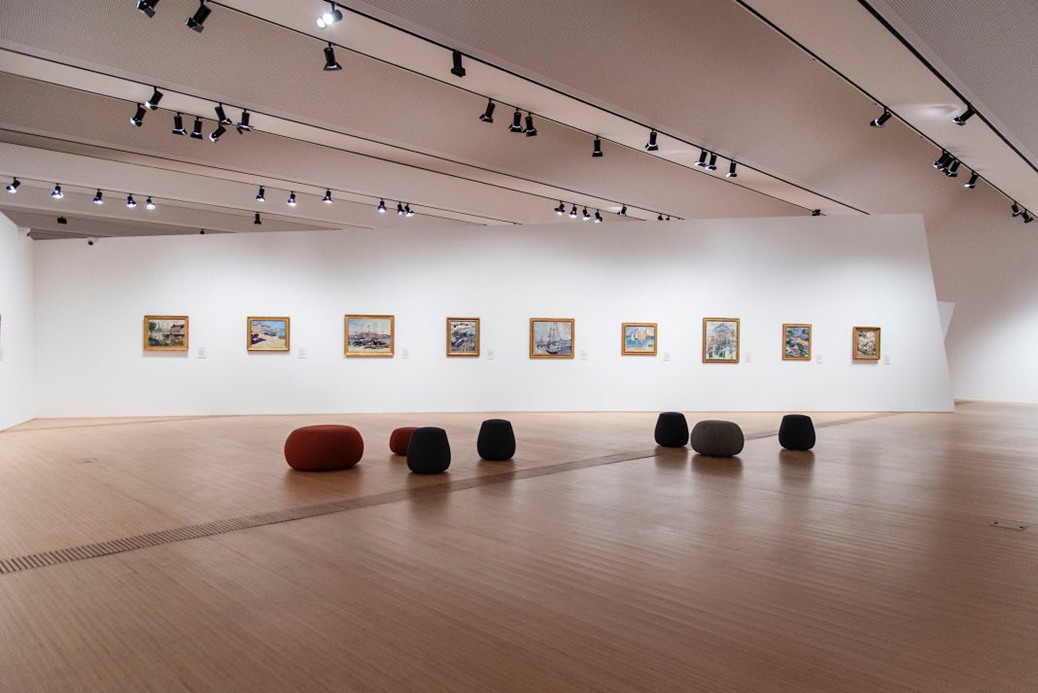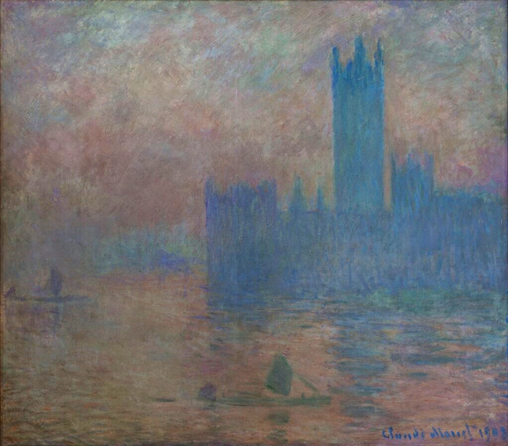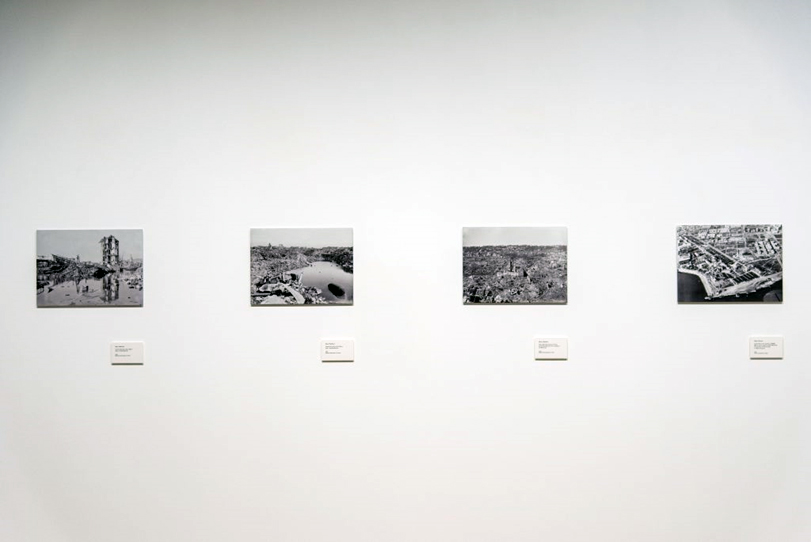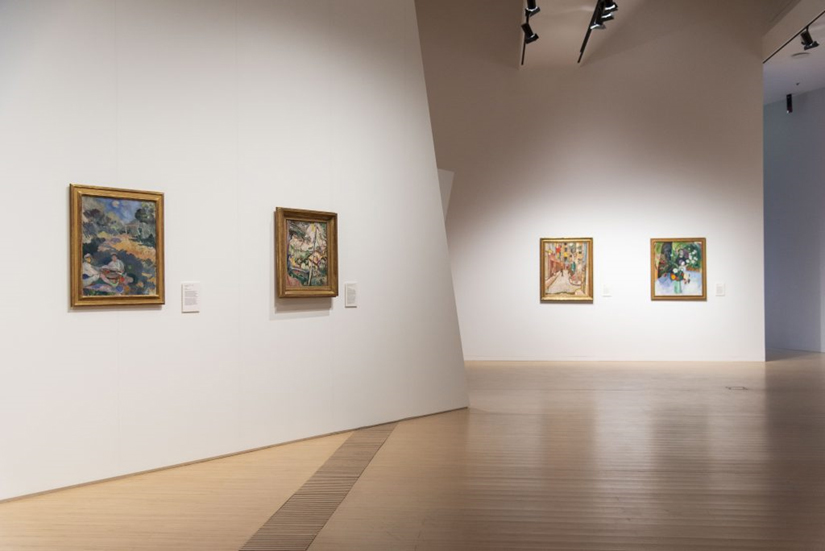
Arte Salvata, M9 Museo del ‘900 Mestre, exhibition view
From March 15 to August 31, 2025, M9 – Museum of the 20th Century in Mestre will host its first temporary exhibition of the year, “Saved Art: Masterpieces Beyond War from the MuMa of Le Havre.” This exhibition aims to highlight the resilience of art in the face of war’s destruction, serving as a shared testimony of historical memory.
There is an apparent sense of serenity when observing “Winter Sun, Lavacourt” by Claude Monet. The light plays on the snow, between muted reflections and a soft orange on the horizon. It converses with “The Seine at Vétheuil,” a place where Monet moved from Paris in the summer of 1878, pressed by financial difficulties and worried about his wife Camille’s health. The Seine is a mirror, its colors reverberating with melancholy. Curated by Géraldine Lefebvre, Director of the MuMa, and Marianne Mathieu, an expert in Impressionism and Post-Impressionism, the exhibition tells stories of rebirth.

Claude Monet, La Senna a Vétheuil (1878; olio su tela, 50,5 x 61,5 cm;
Le Havre, Musée d’Art Moderne André Malraux. Collezione Olivier Senn, donazione Hélène Senn-Foulds, 2004)
© MuMa Le Havre / Charles Maslard

Claude Monet Il parlamento di Londra, effetto nebbia 1903 olio su tela Le Havre, Musée d’Art Moderne André Malraux Donazione dell’artista, 1910 © MuMa Le Havre / David Foge
This initiative is part of M9’s ongoing international collaborations: 51 artworks from the André Malraux Museum of Modern Art in Le Havre (MuMa) will be on display, renowned for its exceptional collection of Impressionist paintings. For the first time, MuMa has loaned a significant portion of its collection in honor of the 80th anniversary of the end of World War II.
The artworks on display, many of which survived the bombings, are symbols of Le Havre’s reconstruction, led by architect Auguste Perret. This process ultimately led to the city being recognized as a UNESCO World Heritage site. The paintings illustrate the city’s artistic evolution, showing how its cultural heritage was integrated into the urban context.
Founded in 1845 during a period of rapid industrial growth, MuMa’s collection was built thanks to contributions from artists, patrons, and collectors, transforming Le Havre into a cultural avant-garde hub. The exhibited works celebrate this contribution, starting with pieces by Eugène Boudin and Claude Monet. The vitality of Impressionism is also represented by Pierre-Auguste Renoir, Alfred Sisley, Maxime Maufra, and Henry Moret, while the Symbolist side is expressed through works by Paul Gauguin, Jean-Francis Auburtin, Ker Xavier Roussel, Maurice Denis, and Marie Droppe. The artistic journey continues with the birth of Fauvism, represented by works from Raoul Dufy and Othon Friesz, alongside southern views by Albert Marquet and Charles Camoin.

Raoul Dufy, Festa marittima a Le Havre
(1925 circa; olio su tela, 91,5 x 111 cm) Le Havre, Musée d’Art Moderne André Malraux. Lascito Émilienne Dufy,
1963 © MuMa Le Havre / Florian Kleinefenn
The connection with Venice
The exhibition chronicles not only the revival of Le Havre, which was 80% destroyed during bombing raids, but also the recovery of Mestre and Porto Marghera, which were deeply affected by the conflict. The encounter between these two locations, 80 years apart, celebrates the power of cultural heritage to preserve and renew collective memory.
“The museum in Le Havre has taught us that art is total,” explains Serena Bertolucci, director of M9 Museum. “You will also find a playlist accompanying the journey. Before reaching the third floor, however, there is a photographic exploration of the urban destruction of Mestre and Marghera during those same years. We are all called to participate in history, to take part in the regeneration represented by our museum.” Through these works, the exhibition aims to represent an ideal passing of the baton between two cities, Le Havre and Mestre, united by the experience of Total War, to emphasize the importance of cultural heritage in keeping collective memory alive.
“There are many similarities between Venice and Le Havre,” emphasizes the president of the Venice Foundation, Vincenzo Marinese. “Both are port cities where the port is a vital point, and both are grounded in chemistry, green chemistry, industrial transformation, and renewables. All of this needs to be tied together with a bond: culture.”
The exhibition experience will be enriched by musical suggestions curated by Venetian musician Dario Falcone. Pieces by Debussy, Ravel, Messiaen, Malipiero, as well as Bach, Mozart, and Chopin (favorites of Dufy), will accompany the visit, offering an immersive experience into the culture of the early 20th century.
The “Saved Art” narrative intertwines with M9’s permanent exhibition, dedicated to Total War and postwar Italy. A photographic section dedicated to the war in Mestre will be displayed on the second and third floors of the museum throughout the exhibition, with a focus on the bombing of March 28, 1944, which claimed the lives of approximately 200 people. The images document the challenges faced by the civilian population, including displaced persons and refugees, as well as the subsequent reconstruction efforts.

Arte Salvata, M9 Museo del ‘900 Mestre, exhibition view
The public program
A rich program of events will accompany the exhibition. It will kick off on March 26 with writer Salvatore Giannella, who will present the stories of Italy’s “art saviors”, those women and men who did so much to protect great works of art during World War II. Further events include talks by historian Lorenzo Benadusi (April 12), which will present the breaking of cultural paradigms and the dawn of modernity between the 18th and 19th centuries. Musician Dario Falcone (April 24) will delve into the work featured in the exhibition during the event “The Symbol and Memory: European Music of the Early 20th Century.” Next, scholars Laura Mariani and Carlotta Sorba (May 21) will engage in a dialogue about the great Italian theatrical actresses between the two centuries, and a final session on June 5 about Mestre and Marghera during the war and reconstruction.
In the immersive M9 Orizzonti room, the video installation “ESCALATION >< INVOLUTION” by artist Alessandro Zannier, supported by OOM, will be projected. The work reflects on the correlation between cultural decay and environmental damage, aligning with the exhibition’s themes. The exhibition is supported by Intesa Sanpaolo as the Main Sponsor, Duferco Energia and Edison as Sponsors, with participation from the Venice Rovigo Chamber of Commerce, Generali – Venice San Marco Agency, and VeneziaèUnica. The media partnership is provided by Rai Radio 3 and Rai Cultura, with the patronage of Rai Veneto.

Arte Salvata, M9 Museo del ‘900 Mestre,
exhibition view
Next appointment at M9, “Identitalia”: Made in Italy takes center stage in Mestre
The second event of the year is Identitalia – The Iconic Italian Brands, a celebration of the industrial and creative heritage of Made in Italy. Curated by Carlo Martino and Francesco Zurlo, the exhibition, promoted by the Ministry of Made in Italy (and scheduled from September 19, 2025, to February 15, 2026), will showcase historic logos, iconic advertisements, and products that symbolize excellence. One hundred Italian companies will open their archives to the public, offering a journey through Italian history and design. The initiative highlights the role of innovation and tradition in the country’s cultural and economic identity, projecting Made in Italy into a contemporary and international dimension.
